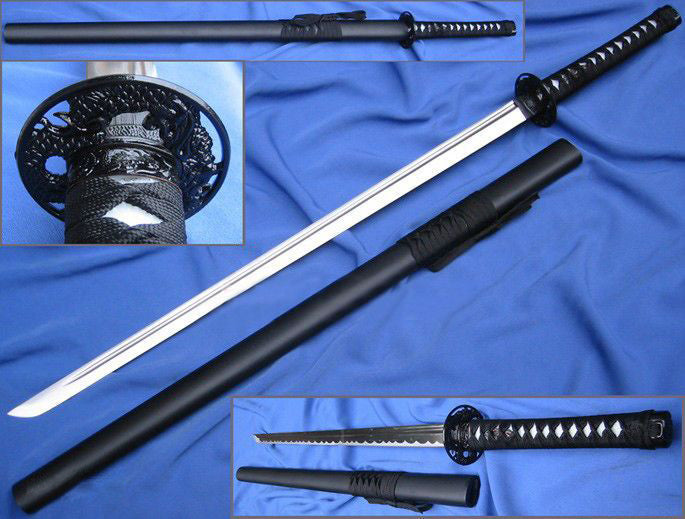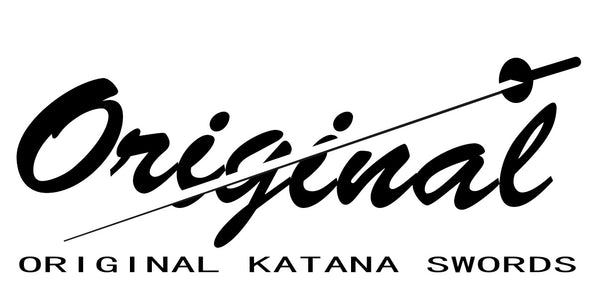
The History of Development of Japanese Samurai Sword (katana)
Share
- Katana(かたな,武士刀)
Katana has been known for its beautiful shape as a weapon since ancient times. Many famous knives have been collected as art collections and contain the symbolic meaning of the soul of the samurai. Different from knives in other countries, one of the biggest characteristics of Japanese swords is that the body itself shows an artistic sense in addition to the decoration of the shape.
Katana can be divided into Tachi(たち,太刀),Uchikatana (うちかたな,打刀(katana,かたな,武士刀)), Wakizashi(わきざし,胁差), tantou(たんとう,短刀), etc. according to shape and size. In a broad sense, it also includes scrolls, naginata, swords, and guns. The knife maker is called "knife maker", "knife maker", or "knife forge" in Japan.
- Development History
The shape of the samurai sword has changed a lot from the late Heian period, through the Kamakura, Northern and Southern Dynasties, Muromachi, Azuchi-Momoyama, Edo, early, mid-term, and late shogunate. The main manifestation is the change from a straight knife to a scimitar. The straight knife is suitable for piercing and the scimitar is suitable for slashing. The reason for this change is mainly caused by the change of fighting style. Starting from the end of Heian period, it is suitable for immediate combat. The knives are constantly being improved.
Ancient times
Iron swords have appeared in the mid-Kofun period (200-771) in Japan, and the raw materials at that time were mainly iron smelting. For example, Saitama Gu’s Inariyama Tumulus and Shimane Gu’s Orogenic Tumulus both have iron swords unearthed. The "Jin Cuo Ming Iron Sword" unearthed from the Inari Mountain Tumulus was made in 471 AD to commemorate the service of Emperor Xionglue. 115 Chinese characters are engraved on the sword. Many swords of this era have been rusted.
The swords before the end of the Heian period were classified as Jyoukotou. The shape of the sword was different from the common Japanese swords, either with a straight blade or with a double edge. Ancient knives are extremely rare and are important archaeological materials.
The Japanese sword originated from China’s ring sword. The steel forging process of horizontal swords introduced in the mainland and North Korea in the 5th and 6th centuries is the origin of the Japanese iron sword forging process. At the same time, the fern hand sword of the Ainu people in Hokkaido is a Japanese original. Its development process: ancient straight-edged sword——Warabi hand sword (late Yayoi period, Kofun period-early Heian period)-Hairy-shaped bracken hand sword — Hairy-shaped large sword — Tachi — Tachi, Uchikatana, Wakizashi, tantou.
The number of swords left over from the early Heian period is quite scarce. The raw material is slightly roughened milled iron, and the appearance is still rod-shaped. The academic changes in the style of Japanese swords, and the question of when and how Japan created the unique machete, have not been fully explained. It is generally believed that straight swords were gradually transformed into scimitars after the Johei Rebellion and the Tenkei Rebellion occurred in the middle of the Heian period (around the 10th century). At the same time, the craftsmanship has also been changed from flat manufacturing to a diamond-like Shinogidukuri kataana. Improvements in the production process made the Japanese sword stronger and sharper. The typical styles of this transition period are the "hairy-shaped broadsword" made of a single piece of iron with the blade handle, and the "unokubi zukuri" katana with a two-edged structure and curved blade. The most famous one used by Shijingong (いせじんぐう) is the one used by Fujiwara Hidego (ふじわらのひでさと).
Tachi era
In the late Heian period, especially during the "first nine-year battle" and the "last three-year battle" where the samurai power was the most active, the samurai mendi power increased, and the Japanese sword developed greatly. For example, Hoki and Bizen countries, which produce high-quality iron ore, as well as Yamashiro and Yamato, which are the political and cultural centers, have different genres of swordsmanship. At this time, Japanese swords are mainly used for immediate decisive battles. For Tachi. The representative work of this period is the "Dojiki" (Hakuchi country's Anzuna system, Japan's national treasure) of "Shotodon Boy" cut by Lai Hikari in Dajiangshan, and the "Little Fox Maru" that the fox helped to create according to legend. (The Sanjo sect system of Shancheng Kingdom was destroyed during World War II). In addition to Anzuna, Sanjo Kosakuzong in Yamashiro (present-day Kyoto) is near Sanjo Kobe, and Kubi-mae Yusari, etc., are considered to be the oldest swordsmiths in existence in which the name of the producer is engraved.
The characteristics of the Taito in the Heian period are: Shinogidukuri (しのぎづくり, 黃造), Iorimune (いおりむね, 庵東), small kissaki, Kyoka, narrow in front and wide in the back, and the shape of the sword is beautiful.
The Japanese sword in the early Kamakura period was similar to that in the late Heian period. The establishment of the samurai political system of the Kamakura Shogunate made the sword world very active. The Emperor Gotoba even set up a Yufan forge, and the month and the month called for the swordsmith to actively encourage the making of knives.
In the middle of the Kamakura period, due to the emphasis on usability, the width and overall width of the knife changed little. The blade is the pig's head Kassaki, and the quality is really strong. At this time tantou production began to prosper.
At the end of the Kamakura period, the two Yuan army invasions and the collapse of the original political system brought great social turmoil, which made the knife industry prosper. The Japanese sword of this period is more bold than the mid-Kamakura style. Inheriting and carrying forward the characteristics of wide blade width and small changes in blade body width, Kassaki is also longer. Tantou, katana, and Tachi all have the same characteristics that appear longer than other periods.
During the Northern and Southern Dynasties, a large number of large swords called Tachi and Nodachi, which were different from the past, appeared in large numbers.
After Muromachi
After the mid-Muromachi period, the Japanese sword changed from Tachi with the blade downward to Uchikatana with the blade upward. Since the transition into the peace period, the demand for domestic swords in Japan has decreased, and Japanese swords have begun to be mass-produced as trade goods, so the quality of Japanese swords has begun to decline. In the war again triggered by the Onin Rebellion, the demand for swords has expanded again, and a large number of crude crafts have appeared to meet the demand, making the quality of Japanese swords even worse.
In the Edo period, forging industries in Edo (now Tokyo) and Osaka (now Osaka) prospered, and famous swordsmiths appeared everywhere. As the peace and prosperity continued, the Japanese sword began to blindly pursue the gorgeous blade writing, and gradually deviated from the essence of practicality. In addition, the decoration of knives such as Tsuba, Menuki, and Habaki began to develop in this era.
After the riots at the end of the Tokugawa period began, the Restorationist who advocated the ancient sword forging method centered on Mizushinko Masahide and others, once again carried forward the practical Japanese sword making method. After that, the sword was called Shinshintou (しんしんとう,新々刀). The Meiji Restoration began just as swordmaking began to prosper again. Fighting was banned in 1873, the police were banned in 1876, and the Japanese sword was rapidly declining. Modern as a traditional craft, the ancient knife-making method is still popular everywhere.
According to historical records, the Portuguese first transmitted Western civilization to Japan in the early days of the Warring States Period in Japan (Note: from 1467 [Onin's Rebellion] until Toyotomi Hideyoshi unified Japan in 1590). On the contrary, Japanese culture is due to the Edo period (note: refers to the Tokugawa shogunate period created by Tokugawa Ieyasu, from 1603 to 1868) the Tokugawa shogunate implemented the [Lock country policy] The influence was not introduced to Europe until the beginning of the nineteenth century.
At that time, Europeans were most surprised and interested in Ukiyo-e (genre painting) and Japanese sword (aka samurai sword), because the artistic charm and production techniques of these two things far exceeded the imagination of Westerners. Ukiyo-e is widely known because it had a considerable influence on the imprint school that emerged in France in the future, but the katana has been regarded as a simple tool of killing under the preconceived and biased concept of people, and has been left out in the cold, even extended to the side. Today, most people still have an inexplicable sense of fear about it.
In fact, before Emperor Meiji promulgated the [Destroyed Sword Order] in 1876, the katana was not only used as a weapon for body protection, but was also regarded by the Japanese as a spiritual weapon that symbolized the traditional spirit of the nation. Now, although it no longer has practical value, it is undeniable that it still occupies a very important position in the evolution of the consciousness of Japanese national beauty.
